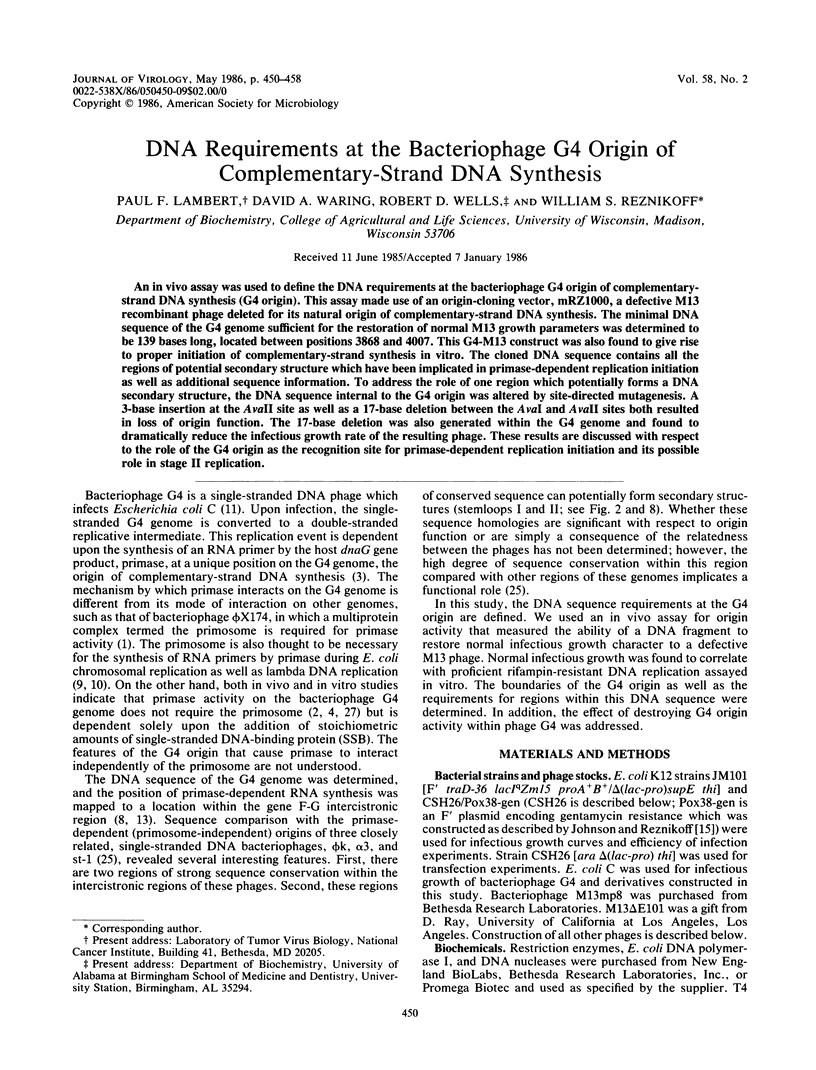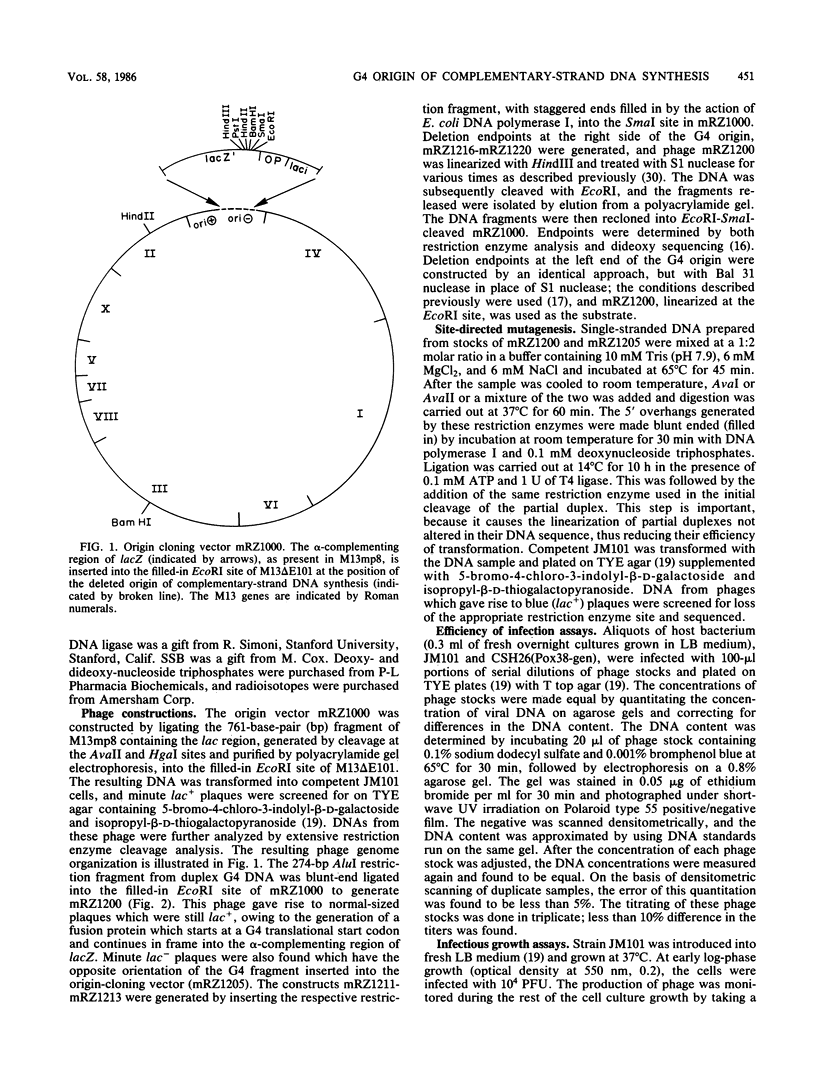Abstract
An in vivo assay was used to define the DNA requirements at the bacteriophage G4 origin of complementary-strand DNA synthesis (G4 origin). This assay made use of an origin-cloning vector, mRZ1000, a defective M13 recombinant phage deleted for its natural origin of complementary-strand DNA synthesis. The minimal DNA sequence of the G4 genome sufficient for the restoration of normal M13 growth parameters was determined to be 139 bases long, located between positions 3868 and 4007. This G4-M13 construct was also found to give rise to proper initiation of complementary-strand synthesis in vitro. The cloned DNA sequence contains all the regions of potential secondary structure which have been implicated in primase-dependent replication initiation as well as additional sequence information. To address the role of one region which potentially forms a DNA secondary structure, the DNA sequence internal to the G4 origin was altered by site-directed mutagenesis. A 3-base insertion at the AvaII site as well as a 17-base deletion between the AvaI and AvaII sites both resulted in loss of origin function. The 17-base deletion was also generated within the G4 genome and found to dramatically reduce the infectious growth rate of the resulting phage. These results are discussed with respect to the role of the G4 origin as the recognition site for primase-dependent replication initiation and its possible role in stage II replication.
Full text
PDF








Selected References
These references are in PubMed. This may not be the complete list of references from this article.
- Arai K., Kornberg A. Unique primed start of phage phi X174 DNA replication and mobility of the primosome in a direction opposite chain synthesis. Proc Natl Acad Sci U S A. 1981 Jan;78(1):69–73. doi: 10.1073/pnas.78.1.69. [DOI] [PMC free article] [PubMed] [Google Scholar]
- Benz E. W., Jr, Reinberg D., Vicuna R., Hurwitz J. Initiation of DNA replication by the dnaG protein. J Biol Chem. 1980 Feb 10;255(3):1096–1106. [PubMed] [Google Scholar]
- Bouché J. P., Rowen L., Kornberg A. The RNA primer synthesized by primase to initiate phage G4 DNA replication. J Biol Chem. 1978 Feb 10;253(3):765–769. [PubMed] [Google Scholar]
- Bouché J. P., Zechel K., Kornberg A. dnaG gene product, a rifampicin-resistant RNA polymerase, initiates the conversion of a single-stranded coliphage DNA to its duplex replicative form. J Biol Chem. 1975 Aug 10;250(15):5995–6001. [PubMed] [Google Scholar]
- Brutlag D., Schekman R., Kornberg A. A possible role for RNA polymerase in the initiation of M13 DNA synthesis. Proc Natl Acad Sci U S A. 1971 Nov;68(11):2826–2829. doi: 10.1073/pnas.68.11.2826. [DOI] [PMC free article] [PubMed] [Google Scholar]
- Dumas L. B., Goltz S., Benesh D. T. Host cell DNA chain initiation protein requirements for replication of bacteriophage G4 replicative-form DNA. J Virol. 1979 Aug;31(2):370–375. doi: 10.1128/jvi.31.2.370-375.1979. [DOI] [PMC free article] [PubMed] [Google Scholar]
- Fiddes J. C., Barrell B. G., Godson G. N. Nucleotide sequences of the separate origins of synthesis of bacteriophage G4 viral and complementary DNA strands. Proc Natl Acad Sci U S A. 1978 Mar;75(3):1081–1085. doi: 10.1073/pnas.75.3.1081. [DOI] [PMC free article] [PubMed] [Google Scholar]
- Fuller R. S., Kaguni J. M., Kornberg A. Enzymatic replication of the origin of the Escherichia coli chromosome. Proc Natl Acad Sci U S A. 1981 Dec;78(12):7370–7374. doi: 10.1073/pnas.78.12.7370. [DOI] [PMC free article] [PubMed] [Google Scholar]
- Godson G. N. Evolution of phi-chi 174. Isolation of four new phi-chi-like phages and comparison with phi-chi 174. Virology. 1974 Mar;58(1):272–289. doi: 10.1016/0042-6822(74)90161-5. [DOI] [PubMed] [Google Scholar]
- Horiuchi K., Zinder N. D. Origin and direction of synthesis of bacteriophage fl DNA. Proc Natl Acad Sci U S A. 1976 Jul;73(7):2341–2345. doi: 10.1073/pnas.73.7.2341. [DOI] [PMC free article] [PubMed] [Google Scholar]
- Hourcade D., Dressler D. Site-specific initiation of a DNA fragment. Proc Natl Acad Sci U S A. 1978 Apr;75(4):1652–1656. doi: 10.1073/pnas.75.4.1652. [DOI] [PMC free article] [PubMed] [Google Scholar]
- Imber R., Low R. L., Ray D. S. Identification of a primosome assembly site in the region of the ori 2 replication origin of the Escherichia coli mini-F plasmid. Proc Natl Acad Sci U S A. 1983 Dec;80(23):7132–7136. doi: 10.1073/pnas.80.23.7132. [DOI] [PMC free article] [PubMed] [Google Scholar]
- Johnson R. C., Reznikoff W. S. Copy number control of Tn5 transposition. Genetics. 1984 May;107(1):9–18. doi: 10.1093/genetics/107.1.9. [DOI] [PMC free article] [PubMed] [Google Scholar]
- Kim M. H., Hines J. C., Ray D. S. Viable deletions of the M13 complementary strand origin. Proc Natl Acad Sci U S A. 1981 Nov;78(11):6784–6788. doi: 10.1073/pnas.78.11.6784. [DOI] [PMC free article] [PubMed] [Google Scholar]
- Kodaira K. I., Taketo A. Conversion of bacteriophage G4 single-stranded viral DNA to double-stranded replicative form in dna mutants of Escherichia coli. Biochim Biophys Acta. 1977 May 17;476(2):149–155. doi: 10.1016/0005-2787(77)90091-0. [DOI] [PubMed] [Google Scholar]
- Nomura N., Low R. L., Ray D. S. Identification of ColE1 DNA sequences that direct single strand-to-double strand conversion by a phi X174 type mechanism. Proc Natl Acad Sci U S A. 1982 May;79(10):3153–3157. doi: 10.1073/pnas.79.10.3153. [DOI] [PMC free article] [PubMed] [Google Scholar]
- Sanger F., Nicklen S., Coulson A. R. DNA sequencing with chain-terminating inhibitors. Proc Natl Acad Sci U S A. 1977 Dec;74(12):5463–5467. doi: 10.1073/pnas.74.12.5463. [DOI] [PMC free article] [PubMed] [Google Scholar]
- Sims J., Benz E. W., Jr Initiation of DNA replication by the Escherichia coli dnaG protein: evidence that tertiary structure is involved. Proc Natl Acad Sci U S A. 1980 Feb;77(2):900–904. doi: 10.1073/pnas.77.2.900. [DOI] [PMC free article] [PubMed] [Google Scholar]
- Sims J., Capon D., Dressler D. dnaG (primase)-dependent origins of DNA replication. Nucleotide sequences of the negative strand initiation sites of bacteriophages St-1, phi K, and alpha 3. J Biol Chem. 1979 Dec 25;254(24):12615–12628. [PubMed] [Google Scholar]
- Vieira J., Messing J. The pUC plasmids, an M13mp7-derived system for insertion mutagenesis and sequencing with synthetic universal primers. Gene. 1982 Oct;19(3):259–268. doi: 10.1016/0378-1119(82)90015-4. [DOI] [PubMed] [Google Scholar]
- Webster R. E., Grant R. A., Hamilton L. A. Orientation of the DNA in the filamentous bacteriophage f1. J Mol Biol. 1981 Oct 25;152(2):357–374. doi: 10.1016/0022-2836(81)90247-3. [DOI] [PubMed] [Google Scholar]
- Yu X. M., Reznikoff W. S. Deletion analysis of the CAP-cAMP binding site of the Escherichia coli lactose promoter. Nucleic Acids Res. 1984 Jul 11;12(13):5449–5464. doi: 10.1093/nar/12.13.5449. [DOI] [PMC free article] [PubMed] [Google Scholar]


